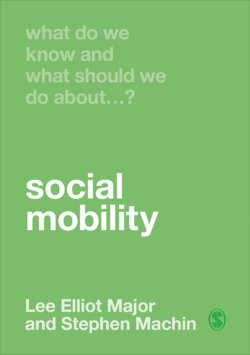Читать книгу What Do We Know and What Should We Do About Social Mobility? - Lee Elliot Major - Страница 9
Measures of Mobility
ОглавлениеIt is important to be clear what social mobility means. Often policy debates and academic studies fall at this first hurdle, with people unclear about what aspect of social mobility they are hoping to improve. In economic research, mobility patterns are usually assessed by studying individual or family earnings and income, with a small set of studies also looking at wealth. In sociology, the changing status of people is studied in terms of social classes, based on the jobs people and their parents do, sometimes considering how much they earn and how much job security they enjoy.1
Both can be tracked within families across generations, providing different insights into where people come from and where they end up. For example, economic studies often rank the population with the richest at the top and the poorest at the bottom, looking at cross-generation movements up and down the income distribution. This means the relative income categories used to classify people can be kept constant across successive generations.2 By contrast, as the composition of the labour market has altered through time, the numbers of people in different social class categories has changed. It may come as little surprise that the economic and sociological approaches have sometimes produced differing estimates of how social mobility has changed over time.
Most of the early research on intergenerational mobility tracked only the status of fathers and their sons. This was because fewer women were working in the labour market in the past, and their patterns of employment were less predictable than those for men. There were therefore prohibitively low sample sizes of mothers with labour earnings in many data sources. This has changed during recent decades as more females have joined the labour force, and richer data have become available. There is a separate literature focusing on many important issues of gender inequality we do not cover. However, where possible we report mobility trends and relevant statistics for women as well as men.
Similarly, the literature has for the most part suffered from a paucity of data tracking the outcomes for people with different ethnic backgrounds. An important emerging research area is gauging intersectional impacts – assessing outcomes for people categorised by status, gender and ethnicity – but the studies are few and far between. Wherever possible we highlight findings for the UK as a whole, but sometimes (especially on school education) we have to make do with data covering just England. Many of the most relevant large-scale data studies also come from the United States, but we will refer to international studies where relevant as well.
Intragenerational mobility, as opposed to intergenerational mobility, refers to movement between income or class positions during a person's own lifetime. Multigenerational mobility refers to transitions over not one, but multiple generations. Social mobility can be short range and long range, featuring a nudge along the income spectrum, or a full rags-to-riches leap. Average social mobility rates conceal large variations for those at the top and bottom of society. Considering the whole distribution as well as the nature of shifts at different points is critical for the study of intergenerational mobility patterns.
Social mobility can be measured in absolute or relative terms. For relative measures, if one person goes up, another one goes down. On the other hand, absolute mobility rates show the percentage of people whose income or class destinations improve or worsen compared with their income or class origins. This can be upward and downward in direction. An example of upward absolute intergenerational mobility would be earning more in real terms than your parents. Alternatively, it occurs when your social class is higher up the class structure. Relative mobility rates on the other hand describe the relative chances of people from different backgrounds moving up or down the income or social ladder. Sociologists sometimes call this social fluidity.
In education debates, social mobility has been used as a more generic term for improving the results of pupils from poorer backgrounds – tied to efforts to close achievement gaps between disadvantaged children and their more privileged peers. The guiding principle is that children should fulfil their potential irrespective of their background. However, as we do not know the status of students’ parents or outcomes of students as adults, these are only indicative measures of social mobility, based on the assumption that the individual benefits from education in the past will continue for future generations.
